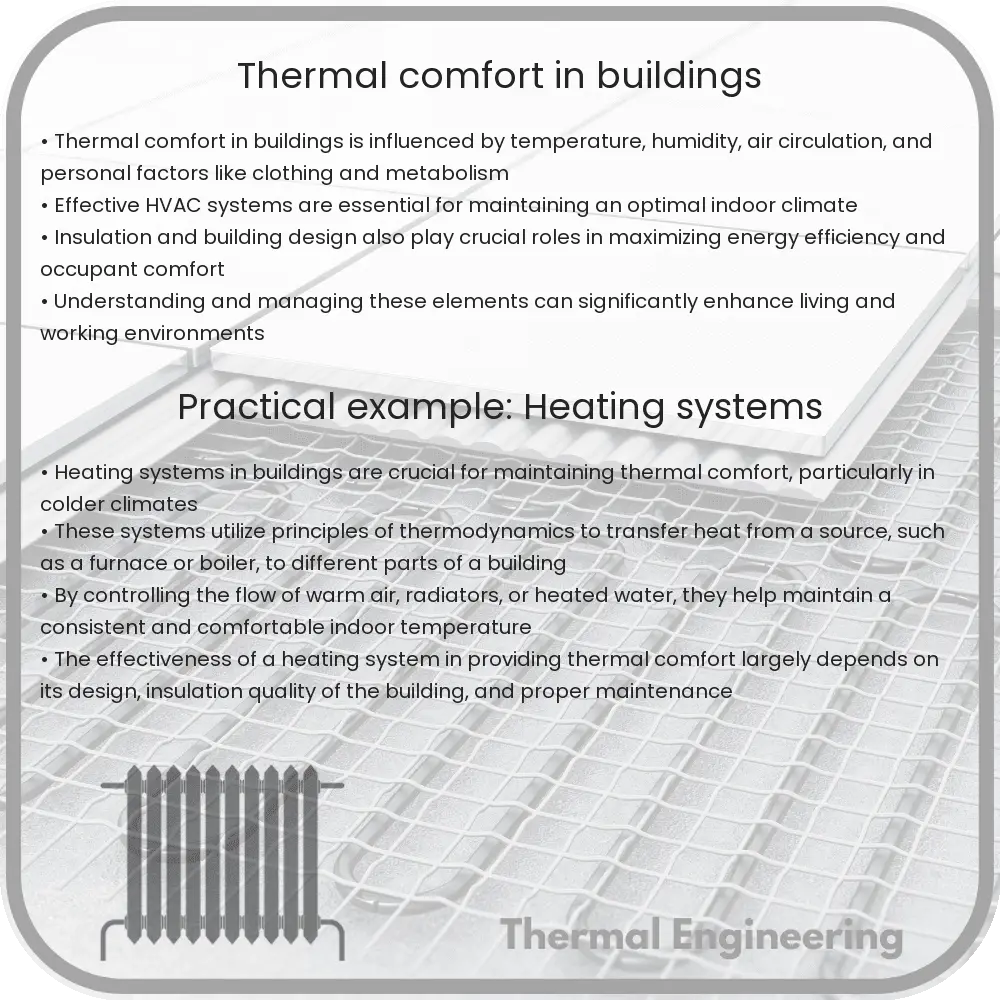Explore how thermal comfort in buildings influences architectural design and engineering for optimal indoor environments.

Understanding Thermal Comfort in Buildings
Thermal comfort in buildings is an essential aspect of architectural design and engineering that deals with creating an indoor environment where occupants feel thermally comfortable. This means maintaining an atmosphere inside buildings where the majority of the occupants feel neither too hot nor too cold. Achieving this balance is crucial for both the health and productivity of individuals, influencing various design decisions in HVAC (Heating, Ventilation, and Air Conditioning) systems, building materials, and layout.
Factors Influencing Thermal Comfort
Thermal comfort is influenced by multiple factors, both environmental and personal. The environmental factors include:
- Air temperature: The measure of how hot or cold the air is in the environment.
- Radiant temperature: The heat emitted by surrounding surfaces that may influence an individual’s thermal sensations.
- Air velocity: The speed at which air moves around; higher velocities can enhance heat loss from the body, making the environment feel cooler.
- Humidity: The amount of moisture in the air. High humidity levels can impede the evaporation of sweat, leading to discomfort.
Personal factors that affect thermal comfort include:
- Metabolic rate: The rate at which a person generates heat from bodily functions and physical activities.
- Clothing insulation: The type and amount of clothing worn, significantly affecting heat exchange between the body and its environment.
The Role of HVAC Systems in Achieving Thermal Comfort
The HVAC systems play a pivotal role in modulating the indoor environment to meet thermal comfort criteria. These systems are designed based on the principles of thermodynamics, fluid mechanics, and heat transfer. They must be properly sized and adjusted according to:
- The characteristics of the building (size, orientation, insulation).
- The climatic conditions of the area.
- The building’s occupancy and usage.
One essential concept in this aspect is the control of air flow and the strategic distribution of conditioned air, ensuring uniform temperature throughout the occupied spaces.
Measurement and Standards
Assessing thermal comfort is not just about individual sensation but adheres to specific standards and models. The American Society of Heating, Refrigerating and Air-Conditioning Engineers (ASHRAE) Standard 55 is one such benchmark, which provides guidelines for acceptable thermal environmental conditions for human occupancy. It employs the PMV (Predicted Mean Vote) and PPD (Predicted Percentage of Dissatisfied) indices calculated using Fanger’s thermal comfort equation:
PMV = (0.303 * e-0.036M + 0.028) * (M – W – 3.05 * (5.73 – 3.96 * 10-3 * M – Pa) – 0.42 * (M – 58.15) – 1.7 * 10-5 * M * (5867 – Pa) – 0.0014 * M * (34 – Ta) – 3.96 * 10-8 * fcl * (Tcl + 273)4 – (Tr + 273)4)
Where:
- M is the metabolic rate,
- W is the mechanical power,
- Pa is the water vapor partial pressure,
- cl is the clothing insulation,
- Ta is the air temperature,
- Tr is the mean radiant temperature, and
- Tcl is the clothing surface temperature.
Future Trends
As the focus on sustainability in building design continues to grow, thermal comfort has also started incorporating energy efficiency. Innovations such as adaptive thermal comfort models allow for greater variability in indoor temperatures considering outdoor conditions, potentially reducing energy usage from HVAC systems. Furthermore, smart building technologies leveraging IoT devices and AI for dynamic environmental control are becoming increasingly prevalent, making indoor climates not only comfortable but also energy efficient and adaptable to each occupant’s personal preferences.
Ultimately, understanding and enhancing thermal comfort in buildings not only involves complex engineering but also a balanced consideration of human interaction with their environments. Through intelligent design and technology, modern day buildings can provide a harmonious balance between comfort and efficiency.